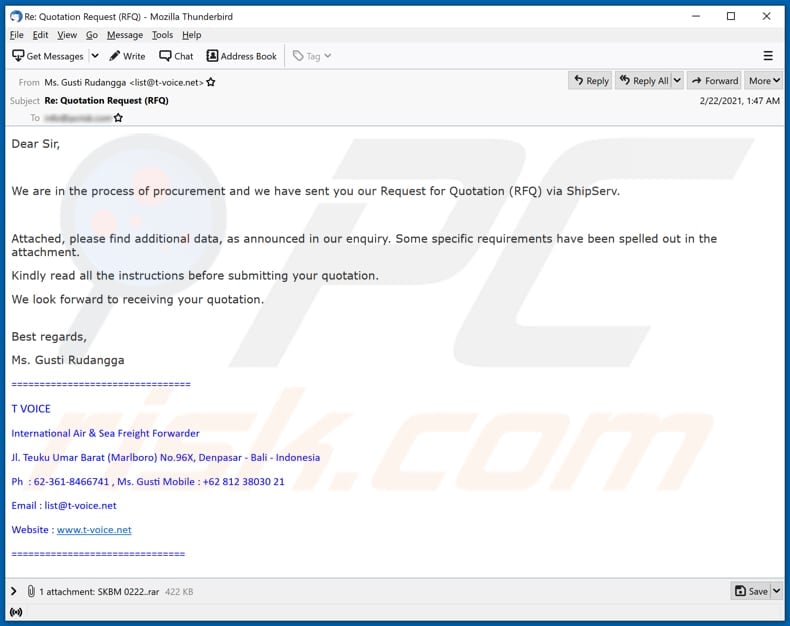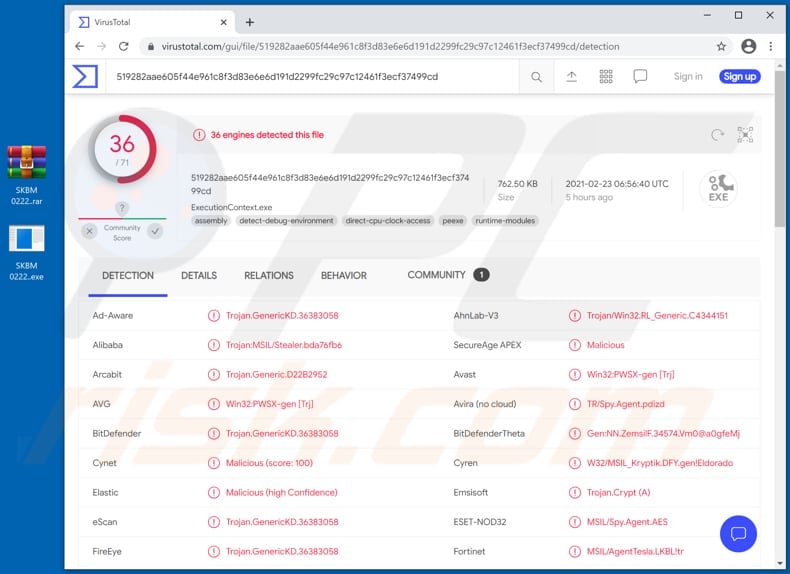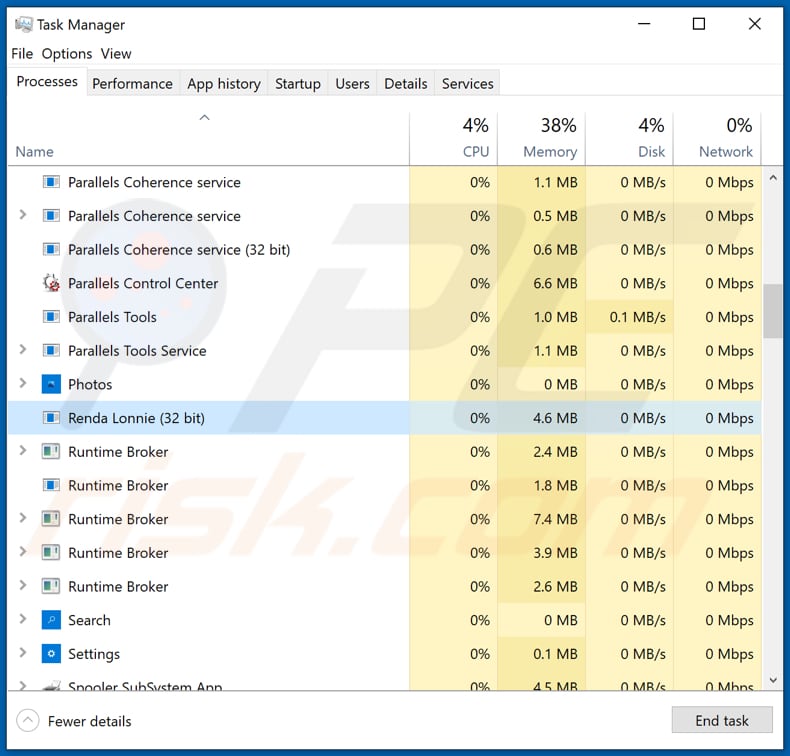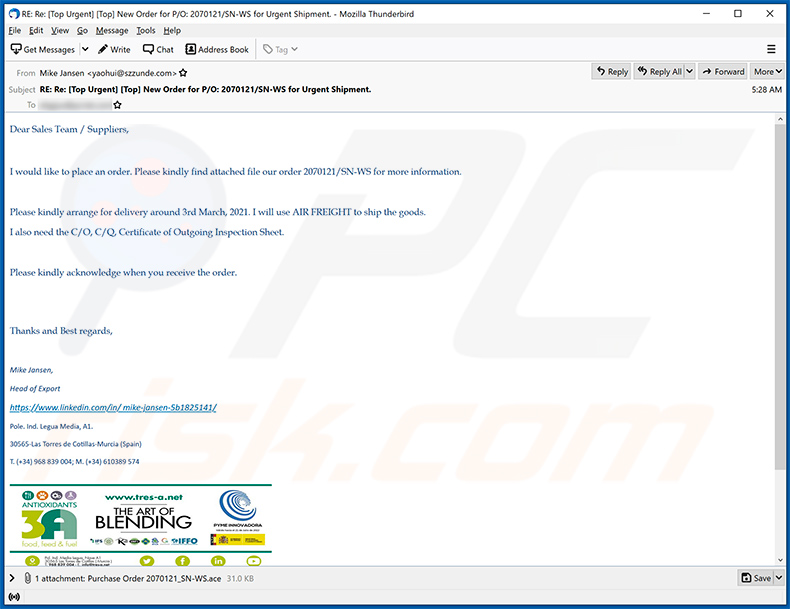Do not open the file in the "International Air & Sea Freight Forwarder" email
Phishing/ScamAlso Known As: International Air & Sea Freight Forwarder spam
Get free scan and check if your device is infected.
Remove it nowTo use full-featured product, you have to purchase a license for Combo Cleaner. Seven days free trial available. Combo Cleaner is owned and operated by RCS LT, the parent company of PCRisk.com.
What is International Air & Sea Freight Forwarder email virus?
This email is a part of a malspam campaign. Cyber criminals use malicious spam to trick recipients into downloading and opening files via malicious URLs, or into opening malicious attachments.
In any case, the main purpose of malspam is to deceive recipients into installing malware (e.g., ransomware, Trojans, crypto miners, information stealers) onto their machines.
Note that cybercriminals often make their malicious emails seem legitimate and trustworthy by disguising them as important, urgent messages from legitimate entities (organizations, companies, etc.).
This email is used to deliver Agent Tesla.

Cyber criminals behind this malpam campaign send emails claiming to be messages from "international air and sea freight forwarder" regarding a request for quotation (RFQ).
Their main goal is to trick recipients into believing that the attached file contains additional data (information). In fact, the attached file is an archive file named "SKBM 0222.rar" (its name may vary) containing a malicious executable file called "SKBM 0222.exe" (this file might also have a different filename), which installs Agent Tesla onto the operating system.
Agent Tesla is a remote administration tool (RAT) capable of logging keyboard input (recording keystrokes). Therefore, cyber criminals can use it to gather login credentials, sensitive data from emails, messaging clients, certain FTP and VPN clients, and download managers. Additionally, this RAT is capable of blocking access to Task Manager and system registry and executing commands via the Command Prompt.
In summary, by executing the file extracted from the attached archive file, recipients can give cyber criminals the capability to steal login credentials such as usernames, email addresses, passwords, credit card details, social security numbers, and other sensitive information, which could be misused for malicious purposes. For example, to steal identities, make fraudulent, unauthorized purchases and transactions, spread phishing and other scams, and trick other people into making monetary transactions.
| Name | International Air & Sea Freight Forwarder spam |
| Threat Type | Trojan, password-stealing virus, banking malware, spyware. |
| Hoax | Email contains a document regarding request for quotation |
| Attachment(s) | SKBM 0222.rar (its name may vary) |
| Detection Names (ExecutionContext.exe) |
Avast (Win32:PWSX-gen [Trj]), BitDefender (Trojan.GenericKD.36383058), ESET-NOD32 (MSIL/Spy.Agent.AES), Kaspersky (HEUR:Trojan.MSIL.Taskun.gen), Microsoft (Trojan:MSIL/Stealer.DR!MTB), Full List Of Detections (VirusTotal) |
| Malicious Process Name | Renda Lonnie (its name may vary) |
| Symptoms | Trojans are designed to stealthily infiltrate the victim's computer and remain silent, and thus no particular symptoms are clearly visible on an infected machine. |
| Payload | Agent Tesla |
| Distribution methods | Infected email attachments, malicious online advertisements, social engineering, software 'cracks'. |
| Damage | Stolen passwords and banking information, identity theft, the victim's computer added to a botnet. |
| Malware Removal (Windows) |
To eliminate possible malware infections, scan your computer with legitimate antivirus software. Our security researchers recommend using Combo Cleaner. Download Combo CleanerTo use full-featured product, you have to purchase a license for Combo Cleaner. 7 days free trial available. Combo Cleaner is owned and operated by RCS LT, the parent company of PCRisk.com. |
More examples of malspam campaigns are "KROHNE Email Virus", "Cobra Industrial Machines Email Virus", and "Coca Cola Email Virus". Malspam is probably the most popular malware delivery channel used by cyber criminals.
Most malspam emails contain a malicious attachment or link, and appear like emails from legitimate, well-known companies or other entities. Some examples of malware also delivered via emails are Dridex, LokiBot, Emotet, and AZORult.
How did "International Air & Sea Freight Forwarder email virus" infect my computer?
This malspam campaign is considered successful only if recipients download the attached RAR archive file, extract it and execute the extracted EXE (executable) file. Malicious attachments only infect computers when recipients open them, however, malicious Word, Excel documents do not install malware unless users also enable macros (editing or content).
Note that malicious MS Office documents can install malware only when users enable editing/content (macros commands). If the documents are opened with MS Office versions prior to 2010, however, the documents install malicious software automatically, since these older versions do not include "Protected View" mode.
These emails often contain malicious attachments or websites designed to download dangerous files. In most cases, cyber criminals send emails that have Microsoft Office documents, archive files (ZIP, RAR), PDF documents, JavaScript files, and executable files such as .exe attached to them. Fake software updating tools do not update or fix any installed software - they simply install malware instead.
How to avoid installation of malware
Do not trust irrelevant emails that have files attached (or contain website links) and are received from unknown, suspicious addresses. Software should not be downloaded or installed through third party downloaders, installers, unofficial pages or other similar sources/tools.
Use only official websites and direct links. Installed software should never be updated or activated with third party, unofficial tools, since they can install malware. Furthermore, it is illegal to use third party tools to activate licensed software.
The only legitimate way to update and activate software is to use tools and functions that are provided by the official developers. Regularly scan your computer with reputable antivirus or anti-spyware software and keep this software up to date.
If you have already opened an "International Air & Sea Freight Forwarder email virus" attachment, we recommend running a scan with Combo Cleaner Antivirus for Windows to automatically eliminate infiltrated malware.
Text presented in the International Air & Sea Freight Forwarder malspam campaign:
Subject: Re: Quotation Request (RFQ)
Dear Sir,
We are in the process of procurement and we have sent you our Request for Quotation (RFQ) via ShipServ.
Attached, please find additional data, as announced in our enquiry. Some specific requirements have been spelled out in the attachment.
Kindly read all the instructions before submitting your quotation.
We look forward to receiving your quotation.
Best regards,
Ms. Gusti Rudangga
================================
T VOICE
International Air & Sea Freight Forwarder
Jl. Teuku Umar Barat (Marlboro) No.96X, Denpasar - Bali - Indonesia
Ph : 62-361-8466741 , Ms. Gusti Mobile : +62 812 38030 21
Email : list@t-voice.net
Website : www.t-voice.net
===============================
Malicious executable detected as a threat in VirusTotal:

Agent Tesla running in Task Manager as "Renda Lonnie" (its name may vary):

Another variant of Air Freight-themed spam email spreading a malicious attachment:

Text presented within:
Subject: RE: Re: [Top Urgent] [Top] New Order for P/O: 2070121/SN-WS for Urgent Shipment.
Dear Sales Team / Suppliers,
I would like to place an order. Please kindly find attached file our order 2070121/SN-WS for more information.
Please kindly arrange for delivery around 3rd March, 2021. I will use AIR FREIGHT to ship the goods.
I also need the C/O, C/Q, Certificate of Outgoing Inspection Sheet.
Please kindly acknowledge when you receive the order.
Thanks and Best regards,
Mike Jansen,
Head of Export
-
Pole. Ind. Legua Media, A1.
30565-Las Torres de Cotillas-Murcia (Spain)
T. (+34) 968 839 004; M. (+34) 610389 574
Instant automatic malware removal:
Manual threat removal might be a lengthy and complicated process that requires advanced IT skills. Combo Cleaner is a professional automatic malware removal tool that is recommended to get rid of malware. Download it by clicking the button below:
DOWNLOAD Combo CleanerBy downloading any software listed on this website you agree to our Privacy Policy and Terms of Use. To use full-featured product, you have to purchase a license for Combo Cleaner. 7 days free trial available. Combo Cleaner is owned and operated by RCS LT, the parent company of PCRisk.com.
Quick menu:
- What is International Air & Sea Freight Forwarder spam?
- Types of malicious emails.
- How to spot a malicious email?
- What to do if you fell for an email scam?
Types of malicious emails:
![]() Phishing Emails
Phishing Emails
Most commonly, cybercriminals use deceptive emails to trick Internet users into giving away their sensitive private information, for example, login information for various online services, email accounts, or online banking information.
Such attacks are called phishing. In a phishing attack, cybercriminals usually send an email message with some popular service logo (for example, Microsoft, DHL, Amazon, Netflix), create urgency (wrong shipping address, expired password, etc.), and place a link which they hope their potential victims will click on.
After clicking the link presented in such email message, victims are redirected to a fake website that looks identical or extremely similar to the original one. Victims are then asked to enter their password, credit card details, or some other information that gets stolen by cybercriminals.
![]() Emails with Malicious Attachments
Emails with Malicious Attachments
Another popular attack vector is email spam with malicious attachments that infect users' computers with malware. Malicious attachments usually carry trojans that are capable of stealing passwords, banking information, and other sensitive information.
In such attacks, cybercriminals' main goal is to trick their potential victims into opening an infected email attachment. To achieve this goal, email messages usually talk about recently received invoices, faxes, or voice messages.
If a potential victim falls for the lure and opens the attachment, their computers get infected, and cybercriminals can collect a lot of sensitive information.
While it's a more complicated method to steal personal information (spam filters and antivirus programs usually detect such attempts), if successful, cybercriminals can get a much wider array of data and can collect information for a long period of time.
![]() Sextortion Emails
Sextortion Emails
This is a type of phishing. In this case, users receive an email claiming that a cybercriminal could access the webcam of the potential victim and has a video recording of one's masturbation.
To get rid of the video, victims are asked to pay a ransom (usually using Bitcoin or another cryptocurrency). Nevertheless, all of these claims are false - users who receive such emails should ignore and delete them.
How to spot a malicious email?
While cyber criminals try to make their lure emails look trustworthy, here are some things that you should look for when trying to spot a phishing email:
- Check the sender's ("from") email address: Hover your mouse over the "from" address and check if it's legitimate. For example, if you received an email from Microsoft, be sure to check if the email address is @microsoft.com and not something suspicious like @m1crosoft.com, @microsfot.com, @account-security-noreply.com, etc.
- Check for generic greetings: If the greeting in the email is "Dear user", "Dear @youremail.com", "Dear valued customer", this should raise suspiciousness. Most commonly, companies call you by your name. Lack of this information could signal a phishing attempt.
- Check the links in the email: Hover your mouse over the link presented in the email, if the link that appears seems suspicious, don't click it. For example, if you received an email from Microsoft and the link in the email shows that it will go to firebasestorage.googleapis.com/v0... you shouldn't trust it. It's best not to click any links in the emails but to visit the company website that sent you the email in the first place.
- Don't blindly trust email attachments: Most commonly, legitimate companies will ask you to log in to their website and to view any documents there; if you received an email with an attachment, it's a good idea to scan it with an antivirus application. Infected email attachments are a common attack vector used by cybercriminals.
To minimise the risk of opening phishing and malicious emails we recommend using Combo Cleaner Antivirus for Windows.
Example of a spam email:

What to do if you fell for an email scam?
- If you clicked on a link in a phishing email and entered your password - be sure to change your password as soon as possible. Usually, cybercriminals collect stolen credentials and then sell them to other groups that use them for malicious purposes. If you change your password in a timely manner, there's a chance that criminals won't have enough time to do any damage.
- If you entered your credit card information - contact your bank as soon as possible and explain the situation. There's a good chance that you will need to cancel your compromised credit card and get a new one.
- If you see any signs of identity theft - you should immediately contact the Federal Trade Commission. This institution will collect information about your situation and create a personal recovery plan.
- If you opened a malicious attachment - your computer is probably infected, you should scan it with a reputable antivirus application. For this purpose, we recommend using Combo Cleaner Antivirus for Windows.
- Help other Internet users - report phishing emails to Anti-Phishing Working Group, FBI’s Internet Crime Complaint Center, National Fraud Information Center and U.S. Department of Justice.
Share:

Tomas Meskauskas
Expert security researcher, professional malware analyst
I am passionate about computer security and technology. I have an experience of over 10 years working in various companies related to computer technical issue solving and Internet security. I have been working as an author and editor for pcrisk.com since 2010. Follow me on Twitter and LinkedIn to stay informed about the latest online security threats.
PCrisk security portal is brought by a company RCS LT.
Joined forces of security researchers help educate computer users about the latest online security threats. More information about the company RCS LT.
Our malware removal guides are free. However, if you want to support us you can send us a donation.
DonatePCrisk security portal is brought by a company RCS LT.
Joined forces of security researchers help educate computer users about the latest online security threats. More information about the company RCS LT.
Our malware removal guides are free. However, if you want to support us you can send us a donation.
Donate
▼ Show Discussion